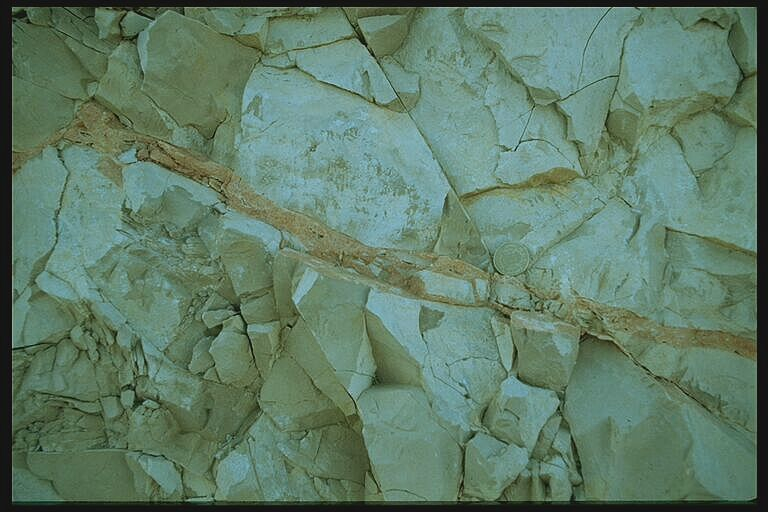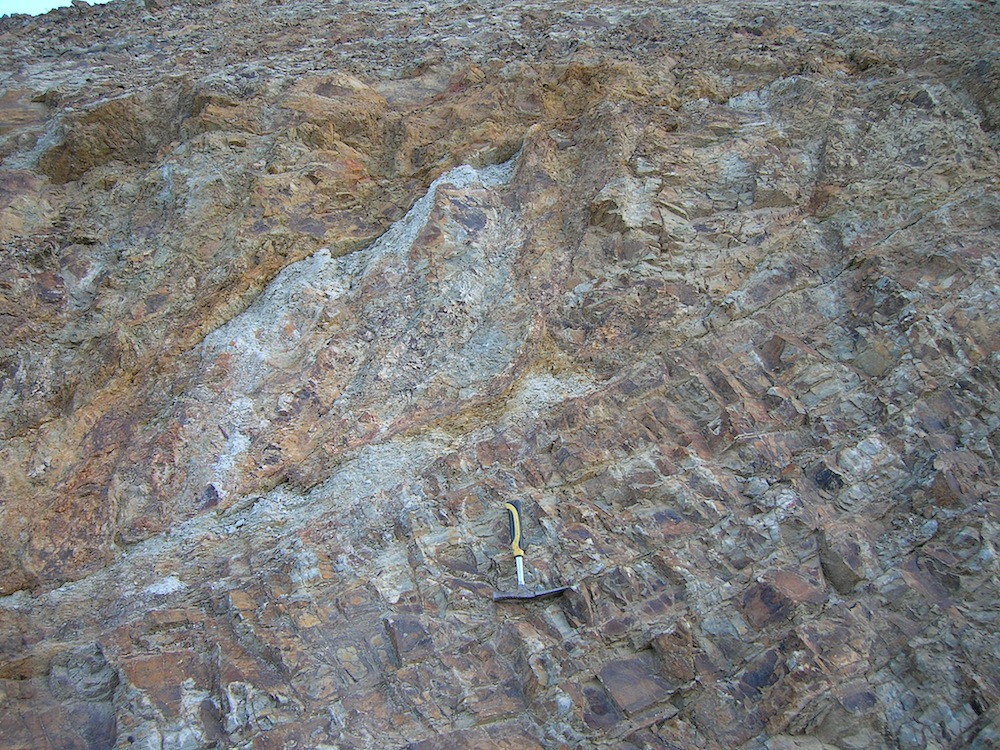A dike in the common geological sense is a mostly tabular body of different materials (minerals, rocks, ores) cross-cutting the host rock. In impact structures, breccia dikes have played an important role in the understanding of the impact cratering process. They have been reported from many impact structures, and they have in detail been investigated e.g. for the Rochechouart (France; P. Lambert, W. Oskierski & L. Bischoff) and the Azuara/Rubielos de la Cérida (Spain; J.Fiebag) structures.
The overabundant inventory of impact breccia dikes and their in general brilliant exposure in the large Spanish impact structures is certainly non-pareil in all other impact structures worldwide. So much the worse that Spanish regional geologists and leading researchers of the so-called impact “community”, the Canadian New Brunswick impact database included, are still steering clear of the prominent Spanish impact structures. (More about this unbelievable situation in the Controversy section.)
It is generally suggested that for the most part the breccia dikes are formed in the excavation stage by injection of brecciated material into the walls and the floor of the expanding excavation cavity. Later formations of breccia dikes in the modification stage incorporating earlier formed ones may lead to generations of breccia dikes.
Although frequently very similar in outcrop conditions, breccia dikes should not be confused with impact pseudotachylites (see https://www.impact-structures.com/impact-rocks-impactites/impact-melt-page-impact-melt-rocks-impact-glasses-and-congeners/). By definition, pseudotachylites are characterized by a melt rock matrix clearly different from the clastic matrix of dike breccias.
H-type breccia dikes
Among the many various types of impact breccia dikes in the big Spanish impact structures a so-called H-type is often observed. A model of formation is shown in Fig. 1.
Fig. 1. Model of formation of H-type impact breccia dikes frequently observed in the Azuara and Rubielos de la Cérida impact structures.
 Fig. 2. System of breccia dikes (H-type) cutting through Liassic limestones. Azuara impact structure (Spain), near Belchite.
Fig. 2. System of breccia dikes (H-type) cutting through Liassic limestones. Azuara impact structure (Spain), near Belchite.
 Fig. 3. H-type breccia dikes in Jurassic limestone, Fuendetodos, Azuara impact structure; Spain.
Fig. 3. H-type breccia dikes in Jurassic limestone, Fuendetodos, Azuara impact structure; Spain.
 Fig. 4. H-type breccia dikes in Muschelkalk limestone, near Rudilla, Azuara impact structure; Spain.
Fig. 4. H-type breccia dikes in Muschelkalk limestone, near Rudilla, Azuara impact structure; Spain.
 Fig. 5. H-type breccia dikes, exposed during construction of the Autovía Mudéjar, Azuara impact structure, Spain.
Fig. 5. H-type breccia dikes, exposed during construction of the Autovía Mudéjar, Azuara impact structure, Spain.
Fig. 6. H-type impact breccia dikes in Jurassic limestones, Fuendetodos, Azuara impact structure. These dikes have nothing in common with any karst features that have been suggested by regional geologists.
Breccia dike Rochechouart (France) impact structure
Fig. 7. Impact breccia dike, Rochechouart impact structure (France). Champagnac quarry. In this quarry breccia dikes together with impact pseudotachylites (see below) are best exposed.
Single breccia dikes
Frequently individual impact breccia dikes are cutting sharply through the host rock without a genetic relation to any tectonics or hydrothermal activity, karstic features basically excluded anyway. Regional geologists unfamiliar with impact phenomena regularly have an answer pat: tectonics or karst.
Fig. 8. Breccia dike sharply cutting through Jurassic limestone. Rim zone of the Rubielos de la Cérida impact basin, near Cervera del Rincón.
Fig. 9. Polymictic breccia dike cutting through Triassic dolostone. Rubielos de Cérida impact basin, near Teruel.
Fig. 10. Breccia dike in Jurassic limestone. Rubielos de la Cérida impact basin (Spain); eastern rim region. Note the sharp-edged breccia clasts and the sharply fragmented host rock excluding any karstification features.

Fig. 11. Breccia dike cutting through Muschelkalk limestone. Rubielos de la Cérida impact basin, near Corbalán. Sharp-edged fractures without any dissolution features exclude confusion with karst structures.
Fig. 12. Concordant and discordant breccia dikes (grayish-greenish) penetrating Cambrian siltstones. Autovía Mudéjar, Azuara impact structure, Spain.
Fig. 13. Detail of the breccia dike in Fig.12. In this case the “breccia” has not the common matrix – clast composition but consists of a finely fractured allochthonous material that has been injected into the well-bedded siltstone.
Breccia dike systems
Systems of closely spaced breccia dikes sharply cutting through their host rock are a prominent impact features in the Spanish large impact structures. Practically in all cases a tectonic or karstic relation can basically and very simply be excluded.
 Fig. 14. System of impact breccia dikes cutting through heavily fractured Paleozoic siltstones. At the top well bedded post-impact Tertiary conglomerates. Rim Zone of the Rubielos de la Cérida impact basin near Lechago.
Fig. 14. System of impact breccia dikes cutting through heavily fractured Paleozoic siltstones. At the top well bedded post-impact Tertiary conglomerates. Rim Zone of the Rubielos de la Cérida impact basin near Lechago.
Fig. 15. Impact breccia dike system; Teruel – Corbalán, Rubielos de la Cérida impact basin, Spain.
Fig. 16. Impact breccia dike system sharply cutting through Jurassic limestones. Barranco de Bocafoz, Azuara impact structure, Spain.
Fig. 17. Impact breccia dike system (the greenish-grayish material) penetrating Paleozoic siltstones. Autovía Mudéjar, Azuara impact structure.
Fig.18. System of closely spaced dark breccia dikes cutting through Paleozoic siltstones. Autovía Mudéjar, Azuara impact structure, Spain.
Breccia dike generations
Breccia dike systems may be characterized as crossing dikes, as dikes running within another breccia dikes, and as breccia dikes traversing another broader breccia zone.
 Fig. 19. Crossing breccia dikes (dike generations) in Malmian limestone. The first emplaced dike (N – S trending) is cut by the younger dike showing ribbon texture probably originating from chemical interactions between dike material and the host rock. Azuara impact structure; near Ventas de Muniesa, Corral de Cámaras. Match-box length 40 mm.
Fig. 19. Crossing breccia dikes (dike generations) in Malmian limestone. The first emplaced dike (N – S trending) is cut by the younger dike showing ribbon texture probably originating from chemical interactions between dike material and the host rock. Azuara impact structure; near Ventas de Muniesa, Corral de Cámaras. Match-box length 40 mm.
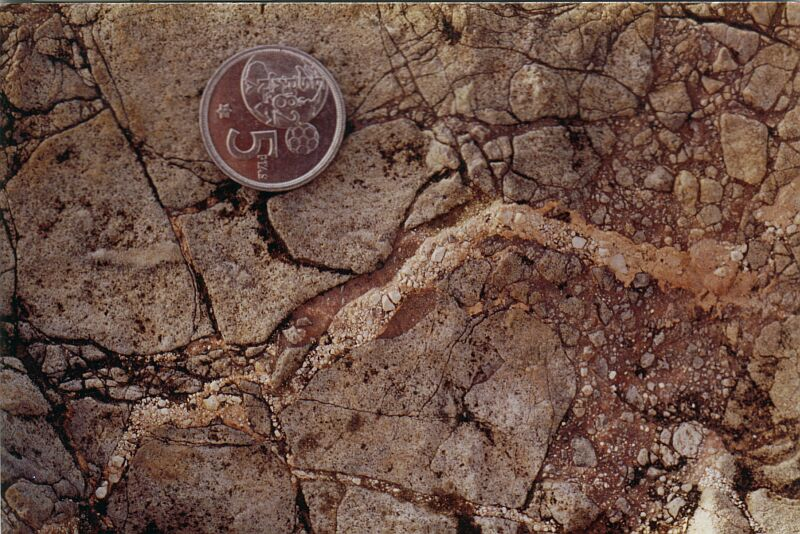 Fig. 20. Impact breccia dike-within-breccia dikes (breccia generations). The emplacement of the second dike (whitish Muschelkalk material) points to a rapid solidification of the first-generation reddish (probably Keuper matrix) dike because of the sharp boundary without any mixing of the dikes’ material. Near Monforte de Moyuela, Azuara impact structure, Spain.
Fig. 20. Impact breccia dike-within-breccia dikes (breccia generations). The emplacement of the second dike (whitish Muschelkalk material) points to a rapid solidification of the first-generation reddish (probably Keuper matrix) dike because of the sharp boundary without any mixing of the dikes’ material. Near Monforte de Moyuela, Azuara impact structure, Spain.
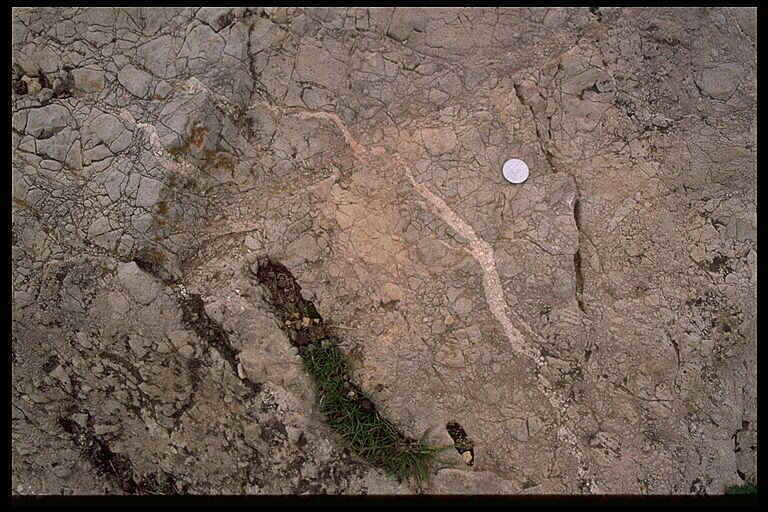 Fig. 21. Thin breccia dike running within a monomictic movement breccia exhibiting mortar texture. Near Monforte de Moyuela, Azuara impact structure, Spain.
Fig. 21. Thin breccia dike running within a monomictic movement breccia exhibiting mortar texture. Near Monforte de Moyuela, Azuara impact structure, Spain.
Thick breccia dikes
Injected breccia dikes may be quite mighty. Not aware of impact structures and impact phenomena earlier geologists in the Azuara field interpreted them, e.g., as small tectonic grabens, suggesting fault throw of up to 200 m.
Fig. 22. Prominent breccia dike cutting through Paleozoic siltstones. Azuara impact structure, route to Virgin de Herrera.
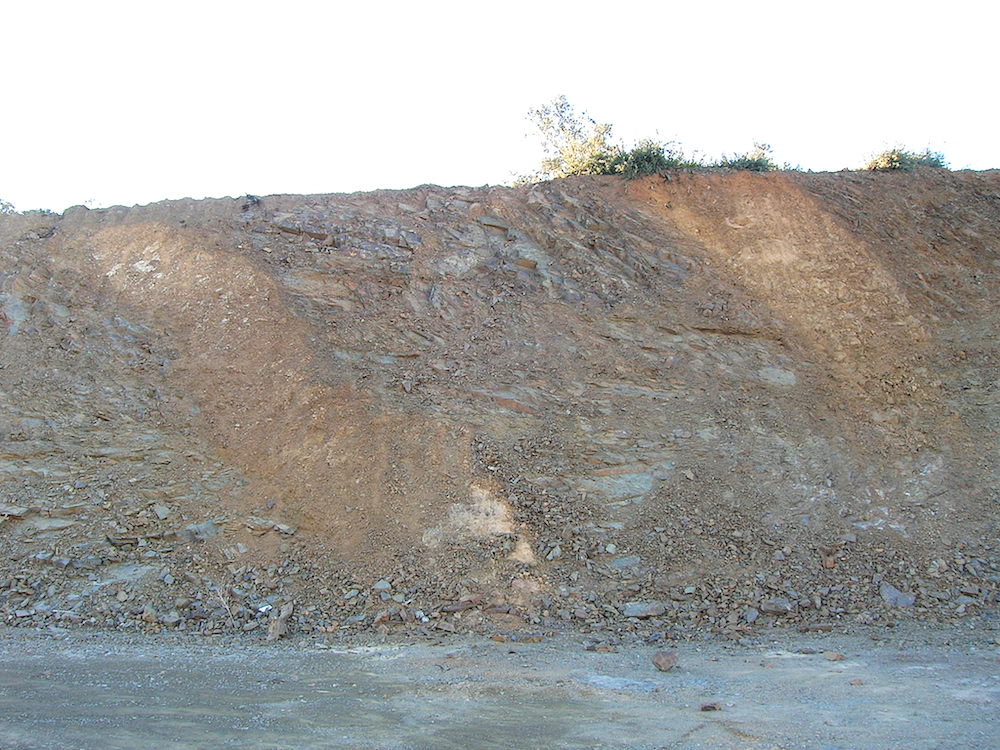 Fig. 23. Thick impact breccia dikes cutting roughly perpendicularly through the bedding of the Paleozoic siltstone. Slope of the Autovía Mudéjar, rim zone of the Azuara impact structure. More about the fascinating impact geology and its engineering implications exposed during construction can be read and seen HERE.
Fig. 23. Thick impact breccia dikes cutting roughly perpendicularly through the bedding of the Paleozoic siltstone. Slope of the Autovía Mudéjar, rim zone of the Azuara impact structure. More about the fascinating impact geology and its engineering implications exposed during construction can be read and seen HERE.
 Fig. 24. Bifurcating breccia dike cutting through Lower Tertiary conglomerates. Rubielos de la Cérida impact basin, near Escorihuela.
Fig. 24. Bifurcating breccia dike cutting through Lower Tertiary conglomerates. Rubielos de la Cérida impact basin, near Escorihuela.
Fig. 25. Prominent breccia dikes cutting through heavily megabrecciated Jurassic limestones. Moyuela, Azuara impact structure.
Fig. 26. Prominent impact breccia dike that because of its strong cementation has resisted weathering and can be traced in the field over more than 300 m. Shock effects are abundant in the sedimentary components. Near Muniesa, Azuara impact structure.
Carbonate melt (?) matrix breccia dikes – possibly pseudotachylites
Fig. 27. Impact breccia dike; carbonate matrix originating from crystallization of carbonate melt or limestone decarbonization and recombination; near Ojos Negros, Rubielos de la Cérida impact basin. In the case of carbonate melt and in the strict sense we are dealing with an impact pseudotachylite (see below).
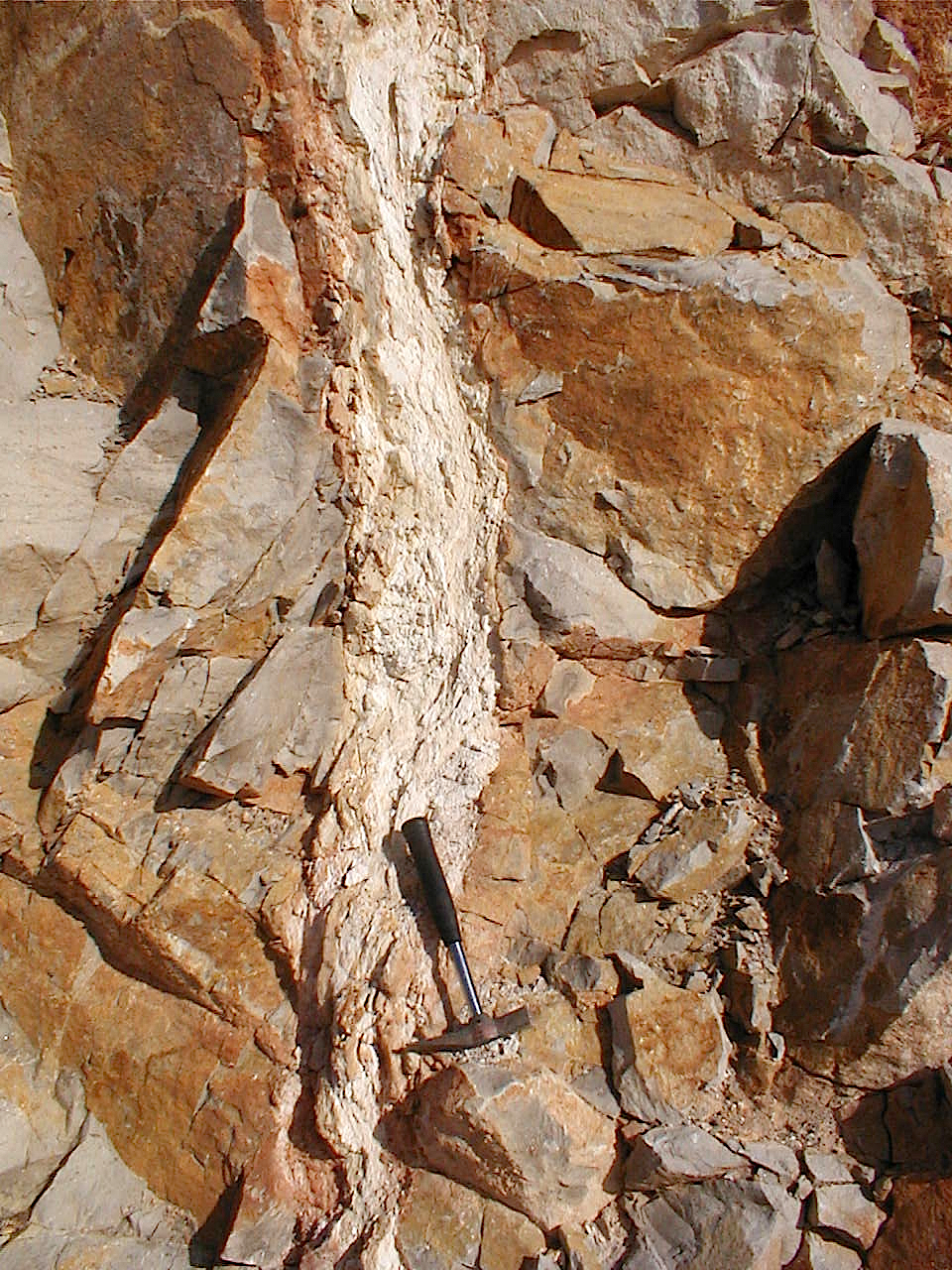 Fig. 28. Similar situation as in Fig. 27: carbonate impact breccia dike with a matrix resulting from carbonate melt or decarbonization. Near Corbalán, Rubielos de la Cérida impact basin, Spain.
Fig. 28. Similar situation as in Fig. 27: carbonate impact breccia dike with a matrix resulting from carbonate melt or decarbonization. Near Corbalán, Rubielos de la Cérida impact basin, Spain.
 Fig. 29. Similar situation as in Fig. 27: carbonate impact breccia dike with a matrix resulting from carbonate melt or decarbonization. Near Rudilla, Azuara impact structure, Spain.
Fig. 29. Similar situation as in Fig. 27: carbonate impact breccia dike with a matrix resulting from carbonate melt or decarbonization. Near Rudilla, Azuara impact structure, Spain.
Special types
 Fig. 30. Spider-like impact breccia dikes running out of a breccia pocket. Near Ventas de Muniesa, Azuara impact structure.
Fig. 30. Spider-like impact breccia dikes running out of a breccia pocket. Near Ventas de Muniesa, Azuara impact structure.
 Fig. 31. Breccia dikes in hand specimen. Muschalkalk limestone, Rubielos de la Cérida impact basin, near Escriche.
Fig. 31. Breccia dikes in hand specimen. Muschalkalk limestone, Rubielos de la Cérida impact basin, near Escriche.
 Fig. 32. Microscopic breccia dike in a quartzite clast of a strongly shocked polymictic dike breccia (breccia-dike generations). Azuara structure. Photomicrograph, plane light and xx polarizers; the field is 5 mm high. Note that the dikelet branching off from the principal dike cuts several quartz grains.
Fig. 32. Microscopic breccia dike in a quartzite clast of a strongly shocked polymictic dike breccia (breccia-dike generations). Azuara structure. Photomicrograph, plane light and xx polarizers; the field is 5 mm high. Note that the dikelet branching off from the principal dike cuts several quartz grains.
For comparison: the Vredefort and Rochechouart pseudotachylite dikes.
Different from the impact breccia dikes with a clastic matrix the pseudotachylites have a matrix solidified from a rock melt. Not always a clear distinction can be made, and various transitions are possible. The emplacements of impact pseudotachylites and impact breccia dikes comply with similar processes.
 Fig. 33. Similar dike emplacement compared with many impact breccia dikes as shown above: Vredefort (South Africa) impact structure.
Fig. 33. Similar dike emplacement compared with many impact breccia dikes as shown above: Vredefort (South Africa) impact structure.
 Fig. 34. One more pseudotachylite dike in the basement of the Vredefort impact structure.
Fig. 34. One more pseudotachylite dike in the basement of the Vredefort impact structure.
 Fig. 35. Impact pseudotachylite dike, Champagnac, Rochechouart impact structure, France.
Fig. 35. Impact pseudotachylite dike, Champagnac, Rochechouart impact structure, France.












































































